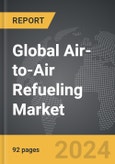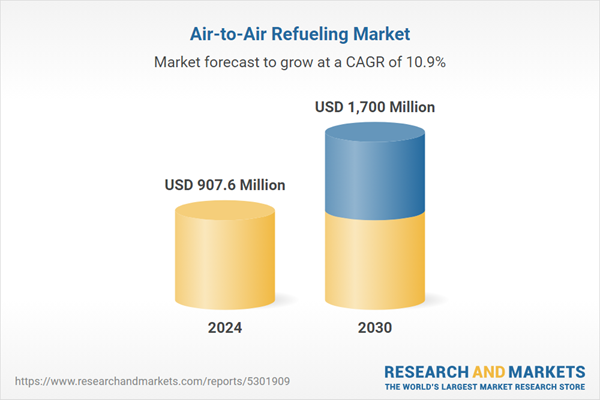Global Air-to-Air Refueling Market - Key Trends and Drivers Summarized
Why Is Air-to-Air Refueling Critical for Modern Military Operations?
Air-to-air refueling, also known as aerial refueling, has become an indispensable component of modern military operations. But why is it so critical in today's combat and reconnaissance missions? The process allows aircraft to extend their range and mission duration by refueling mid-flight, eliminating the need to return to base for refueling. This capability is especially vital for military forces operating across vast geographical areas or in remote regions where there are limited airbases or refueling stations. By enabling fighter jets, bombers, reconnaissance planes, and even transport aircraft to stay airborne longer, air-to-air refueling enhances the operational reach of air forces, giving them a significant strategic advantage. This ability to refuel mid-flight also allows aircraft to carry heavier payloads, such as weapons and surveillance equipment, rather than additional fuel tanks, thus improving mission effectiveness. In today's fast-paced and globalized military landscape, rapid response and sustained presence are essential. Air-to-air refueling allows air forces to maintain continuous air patrols, conduct long-range strike missions, and carry out extended surveillance operations without the limitation of fuel constraints. This capability ensures that air power can be projected across the globe, providing both tactical flexibility and strategic deterrence. Whether supporting combat missions, humanitarian relief operations, or training exercises, air-to-air refueling is a key enabler of modern air force operations, ensuring that forces can remain agile and ready in any scenario.How Does Air-to-Air Refueling Work and What Are the Key Technologies?
The process of air-to-air refueling is complex, but how exactly does it work, and what technologies make it possible? The basic concept involves one aircraft, known as the tanker, transferring fuel to another aircraft, called the receiver, while both are flying in close formation at high speeds. There are two main methods of air-to-air refueling: the probe-and-drogue system and the flying boom system. In the probe-and-drogue method, the receiver aircraft is equipped with a probe that connects to a hose trailing from the tanker. At the end of the hose is a basket-like drogue, which stabilizes the hose in the air. The pilot of the receiving aircraft must carefully guide the probe into the drogue to establish the connection, allowing fuel to flow from the tanker to the receiver. The flying boom system, on the other hand, is a more advanced and precise method. It involves the tanker deploying a rigid, telescoping boom, which is guided by a boom operator from the tanker to the receiver aircraft's receptacle. The boom can transfer fuel at a much faster rate than the probe-and-drogue system, making it the preferred method for refueling large aircraft, such as bombers or transport planes. Both systems require precise coordination and skill from the pilots and crew involved, as they must maintain stable flight in close proximity while traveling at high speeds. Additionally, modern tankers are equipped with advanced communication and guidance systems that assist in positioning the aircraft and ensuring a smooth and safe refueling operation. These technologies are critical to the success of air-to-air refueling missions, which must often be carried out in challenging conditions such as low visibility, high turbulence, or combat zones.What Are the Strategic and Tactical Benefits of Air-to-Air Refueling?
Air-to-air refueling offers a wide array of strategic and tactical benefits, but what makes it such a powerful tool for military planners? One of the primary advantages is the extension of operational reach, allowing aircraft to conduct missions over greater distances without the need to land for fuel. This capability is especially important for nations with global military commitments, as it enables air forces to respond quickly to crises or threats in distant regions. In the context of air combat, refueling allows fighter jets to remain on station for longer periods, providing air cover, performing air interdiction missions, or offering close air support for ground troops. This continuous presence can tip the balance in fast-moving combat situations, allowing for sustained operations and increased mission effectiveness. Beyond combat operations, air-to-air refueling plays a critical role in intelligence, surveillance, and reconnaissance (ISR) missions. ISR aircraft often need to remain airborne for extended periods to monitor large areas, track enemy movements, or gather critical intelligence. By refueling in-flight, these aircraft can maximize their loiter time over target areas, enhancing situational awareness and providing valuable real-time information to commanders on the ground. Similarly, during humanitarian missions or disaster relief operations, transport aircraft that are refueled mid-air can deliver supplies to remote or hard-to-reach areas without the need for frequent stops.What's Driving the Development of the Air-to-Air Refueling Market?
The air-to-air refueling market is expanding, driven by several key factors that are shaping its growth. One major driver is the increasing demand for military aircraft capable of extended operations, especially as global military forces look to enhance their power projection and operational endurance. As geopolitical tensions rise in various regions, nations are investing in advanced aerial refueling platforms to support long-range strike capabilities, extended air patrols, and increased reconnaissance missions. This trend is especially prominent in countries with large geographical expanses or global military commitments, such as the United States, China, and Russia, where the ability to refuel mid-flight is essential for maintaining air dominance and global reach. Technological advancements are also a significant factor in the growth of the air-to-air refueling market. Modern tankers, such as the Boeing KC-46 Pegasus, are equipped with state-of-the-art refueling systems, enhanced automation, and improved fuel efficiency. These technological improvements not only increase the operational capability of the aircraft but also reduce the risk of human error during refueling missions, making the process safer and more reliable. Additionally, the development of unmanned aerial refueling drones is an emerging trend that could revolutionize the market, providing a more cost-effective and flexible solution for air forces looking to reduce the reliance on manned tanker aircraft. Furthermore, the rise of multinational military alliances, such as NATO, has created a need for interoperability in air-to-air refueling systems. Standardization of refueling equipment and protocols allows allied nations to share resources and support each other's aircraft during joint operations, which has driven the demand for compatible refueling platforms. Finally, increased defense budgets and the growing need for air mobility and force projection capabilities have led to greater investments in aerial refueling fleets worldwide. This combination of strategic necessity, technological innovation, and international cooperation is propelling the air-to-air refueling market forward, ensuring its continued development in the years to come.Report Scope
The report analyzes the Air-to-Air Refueling market, presented in terms of market value (US$ Thousand). The analysis covers the key segments and geographic regions outlined below.- Segments: Component (Fuel Tanks, Pumps, Valves, Nozzles, Hoses, Booms, Probes, Pods, Other Components); System (Boom Refueling, Probe & Drogue, Autonomous); Type (Manned, Unmanned).
- Geographic Regions/Countries:World; United States; Canada; Japan; China; Europe (France; Germany; Italy; United Kingdom; Spain; Russia; and Rest of Europe); Asia-Pacific (Australia; India; South Korea; and Rest of Asia-Pacific); Latin America (Argentina; Brazil; Mexico; and Rest of Latin America); Middle East (Iran; Israel; Saudi Arabia; United Arab Emirates; and Rest of Middle East); and Africa.
Key Insights:
- Market Growth: Understand the significant growth trajectory of the Fuel Tanks Component segment, which is expected to reach US$458.6 Million by 2030 with a CAGR of a 13.4%. The Pumps Component segment is also set to grow at 11.8% CAGR over the analysis period.
- Regional Analysis: Gain insights into the U.S. market, valued at $232.3 Million in 2024, and China, forecasted to grow at an impressive 14.7% CAGR to reach $404.5 Million by 2030. Discover growth trends in other key regions, including Japan, Canada, Germany, and the Asia-Pacific.
Why You Should Buy This Report:
- Detailed Market Analysis: Access a thorough analysis of the Global Air-to-Air Refueling Market, covering all major geographic regions and market segments.
- Competitive Insights: Get an overview of the competitive landscape, including the market presence of major players across different geographies.
- Future Trends and Drivers: Understand the key trends and drivers shaping the future of the Global Air-to-Air Refueling Market.
- Actionable Insights: Benefit from actionable insights that can help you identify new revenue opportunities and make strategic business decisions.
Key Questions Answered:
- How is the Global Air-to-Air Refueling Market expected to evolve by 2030?
- What are the main drivers and restraints affecting the market?
- Which market segments will grow the most over the forecast period?
- How will market shares for different regions and segments change by 2030?
- Who are the leading players in the market, and what are their prospects?
Report Features:
- Comprehensive Market Data: Independent analysis of annual sales and market forecasts in US$ Million from 2024 to 2030.
- In-Depth Regional Analysis: Detailed insights into key markets, including the U.S., China, Japan, Canada, Europe, Asia-Pacific, Latin America, Middle East, and Africa.
- Company Profiles: Coverage of players such as Airbus, BAE Systems, Cobham PLC, Draken International, Eaton Corporation and more.
- Complimentary Updates: Receive free report updates for one year to keep you informed of the latest market developments.
Some of the 36 companies featured in this Air-to-Air Refueling market report include:
- Airbus
- BAE Systems
- Cobham PLC
- Draken International
- Eaton Corporation
- GE Aviation
- Israel Aerospace Industries
- Lockheed Martin Corporation
- Marshall Aerospace and Defence Group
- Parker Hannifin Corporation
This edition integrates the latest global trade and economic shifts into comprehensive market analysis. Key updates include:
- Tariff and Trade Impact: Insights into global tariff negotiations across 180+ countries, with analysis of supply chain turbulence, sourcing disruptions, and geographic realignment. Special focus on 2025 as a pivotal year for trade tensions, including updated perspectives on the Trump-era tariffs.
- Adjusted Forecasts and Analytics: Revised global and regional market forecasts through 2030, incorporating tariff effects, economic uncertainty, and structural changes in globalization. Includes historical analysis from 2015 to 2023.
- Strategic Market Dynamics: Evaluation of revised market prospects, regional outlooks, and key economic indicators such as population and urbanization trends.
- Innovation & Technology Trends: Latest developments in product and process innovation, emerging technologies, and key industry drivers shaping the competitive landscape.
- Competitive Intelligence: Updated global market share estimates for 2025, competitive positioning of major players (Strong/Active/Niche/Trivial), and refined focus on leading global brands and core players.
- Expert Insight & Commentary: Strategic analysis from economists, trade experts, and domain specialists to contextualize market shifts and identify emerging opportunities.
Table of Contents
Companies Mentioned (Partial List)
A selection of companies mentioned in this report includes, but is not limited to:
- Airbus
- BAE Systems
- Cobham PLC
- Draken International
- Eaton Corporation
- GE Aviation
- Israel Aerospace Industries
- Lockheed Martin Corporation
- Marshall Aerospace and Defence Group
- Parker Hannifin Corporation
Table Information
| Report Attribute | Details |
|---|---|
| No. of Pages | 384 |
| Published | December 2025 |
| Forecast Period | 2024 - 2030 |
| Estimated Market Value ( USD | $ 907.6 Million |
| Forecasted Market Value ( USD | $ 1700 Million |
| Compound Annual Growth Rate | 10.9% |
| Regions Covered | Global |









